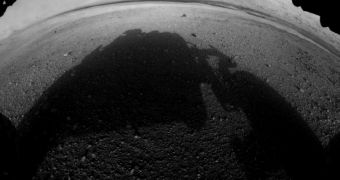On Monday morning GMT (Sunday evening PDT), NASA’s Curiosity rover, the most sophisticated machinery that the humankind has sent to Mars, landed on the Red Planet.
This was a great achievement for NASA, as the landing was one of the most complex ever tried, and it has been declared a success so far.
However, the scientists from NASA's Jet Propulsion Laboratory in Pasadena, Calif., still have to perform a lot of testing before putting the rover to work, a process that is expected to take about a month.
Before that, however, we had the chance to have a look at the first images that Curiosity sent home after the landing, and we can now watch a stop-motion video of its landing.
The video puts together 297 color, low-resolution images taken by the onboard Mars Descent Imager (MARDI), with the first of them showing the entry vehicle's heat shield falling away, while the last one depicts the cloud of dust stirred by exhaust from four of the descent stage's thrust rockets.
These images provide info on Curiosity’s last two minutes of descent, but they are only a preview of the around 1,504 images of the descent that the rover currently holds in its memory.
When put together, these high-resolution images should provide a better view of rover’s descent on Mars’ surface, from the point when the entry system's heat shield is released to the moment of touchdown.
"The image sequence received so far indicates Curiosity had, as expected, a very exciting ride to the surface," said Mike Malin, imaging scientist for the Mars Science Lab mission from Malin Space Systems in San Diego.
"But as dramatic as they are, there is real other-world importance to obtaining them. These images will help the mission scientists interpret the rover's surroundings, the rover drivers in planning for future drives across the surface, as well as assist engineers in their design of forthcoming landing systems for Mars or other worlds."
While the MARDI images sent home so far are low-resolution thumbnails, 192 by 144 pixels, the photos currently stored in rover’s memory are full-frame images 1,600 by 1,200 pixels in size.
Curiosity's black-and-white Hazard Avoidance Cameras – or Hazcams – is also capable of taking high-resolution photos, and one of them was sent to Earth yesterday, following the first set of low-resolution images. It can be seen above to the left, while the stop-motion video has been embedded below.

 14 DAY TRIAL //
14 DAY TRIAL //